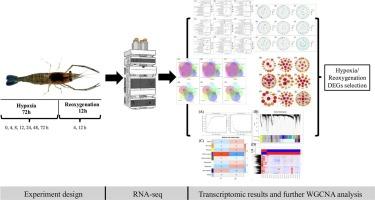Transcriptomic WGCNA analyses reveal sectional regulatory mechanisms in giant freshwater prawn Macrobrachium rosenbergii larvae under hypoxia-reoxygenation
IF 2.2
2区 生物学
Q4 BIOCHEMISTRY & MOLECULAR BIOLOGY
Comparative Biochemistry and Physiology D-Genomics & Proteomics
Pub Date : 2025-08-05
DOI:10.1016/j.cbd.2025.101596
引用次数: 0
Abstract
Hypoxia is a considerable challenge for the prawn culture, especially in high-density intensive aquaculture. The giant freshwater prawn, Macrobrachium rosenbergii, is an economically important species in Asia and South America. However, M. rosenbgergii larvae typically exhibit low resistance to hypoxic stress. To explore the molecular mechanism of hypoxia-reoxygenation on M. rosenbergii larvae, the transcriptomic WGCNA analysis was conducted to detect the dynamic regulatory mechanisms of M. rosenbergii larvae under 4, 8, 12, 24, 48, 72 h of hypoxia stress and 4, 12 h of reoxygenation stress. The results showed that a total of 3173 differentially expressed genes (DEGs) were identified in the gills (1812 up-regulated, 1361 down-regulated), 397 in the hepatopancreas (171 up-regulated, 226 down-regulated), and 768 in the muscle (374 up-regulated, 394 down-regulated). The gills were labeled as the primary functional organ by significantly abundant DEGs during hypoxia-reoxygenation. Additionally, 22 DEGs of 9 gene families were co-expressed during hypoxia-reoxygenation, including the cell protein (CP), cathelicidin associated protein (CAP), aminocyclopropane-1-carboxylate oxidase (ACO) families, etc. For the GO analysis during hypoxia-reoxygenation, the DEGs were mainly enriched in the cellular component and molecular function terms, including nucleolus, mitochondrion, and mRNA binding terms. Besides, the DEGs during hypoxia were significantly enriched in genetic and environmental information pathways involving the HIF-1 signaling pathway and ribosome. Additionally, the DEGs during reoxygenation were mainly associated with cellular processes, including lysosome, phagosome, and apoptosis. Furthermore, 30 candidate hypoxia-reoxygenation module-related DEGs were screened by WGCNA, involving SpAN, TIF-2, Titin, ATP binding cassette, L-ThrDH, G6DP, etc. Overall, these results may reveal the immunological regulatory mechanisms of M. rosenbergii larvae under hypoxia-reoxygenation stress and enrich practical reference materials underlying high-density intensive aquaculture.

转录组学WGCNA分析揭示了罗氏沼虾幼虾在缺氧复氧条件下的分段调控机制
缺氧是对虾养殖面临的一个相当大的挑战,特别是在高密度集约化养殖中。罗氏沼虾(Macrobrachium rosenbergii)是亚洲和南美洲重要的经济物种。然而,罗氏蝇幼虫对缺氧胁迫的抵抗力一般较低。为探索缺氧-再氧化对罗氏沼虾幼虫的分子机制,通过转录组学WGCNA分析,检测罗氏沼虾幼虫在缺氧胁迫4、8、12、24、48、72 h和4、12 h再氧化胁迫下的动态调控机制。结果显示,在鱼鳃中共鉴定出3173个差异表达基因(deg),其中1812个表达上调,1361个表达下调;在肝胰腺中鉴定出397个差异表达基因(171个表达上调,226个表达下调);在肌肉中鉴定出768个差异表达基因(374个表达上调,394个表达下调)。在缺氧复氧过程中,大量的DEGs标志着鳃是主要的功能器官。在缺氧再氧化过程中共表达9个基因家族的22个deg,包括细胞蛋白(CP)、抗菌肽相关蛋白(CAP)、氨基环丙烷-1-羧酸氧化酶(ACO)家族等。在缺氧-复氧氧化石墨烯分析中,DEGs主要富集于细胞成分和分子功能项,包括核仁、线粒体和mRNA结合项。此外,缺氧时的deg在HIF-1信号通路和核糖体等遗传和环境信息通路中显著富集。此外,再氧化过程中的deg主要与细胞过程有关,包括溶酶体、吞噬体和细胞凋亡。此外,WGCNA还筛选了30个候选缺氧再氧化模块相关的deg,包括SpAN、TIF-2、Titin、ATP结合盒、L-ThrDH、G6DP等。综上所述,本研究结果可揭示罗氏沼虾在缺氧复氧胁迫下的免疫调控机制,为高密度集约化养殖提供实用参考资料。
本文章由计算机程序翻译,如有差异,请以英文原文为准。
求助全文
约1分钟内获得全文
求助全文
来源期刊
CiteScore
5.10
自引率
3.30%
发文量
69
审稿时长
33 days
期刊介绍:
Comparative Biochemistry & Physiology (CBP) publishes papers in comparative, environmental and evolutionary physiology.
Part D: Genomics and Proteomics (CBPD), focuses on “omics” approaches to physiology, including comparative and functional genomics, metagenomics, transcriptomics, proteomics, metabolomics, and lipidomics. Most studies employ “omics” and/or system biology to test specific hypotheses about molecular and biochemical mechanisms underlying physiological responses to the environment. We encourage papers that address fundamental questions in comparative physiology and biochemistry rather than studies with a focus that is purely technical, methodological or descriptive in nature.

 求助内容:
求助内容: 应助结果提醒方式:
应助结果提醒方式:


